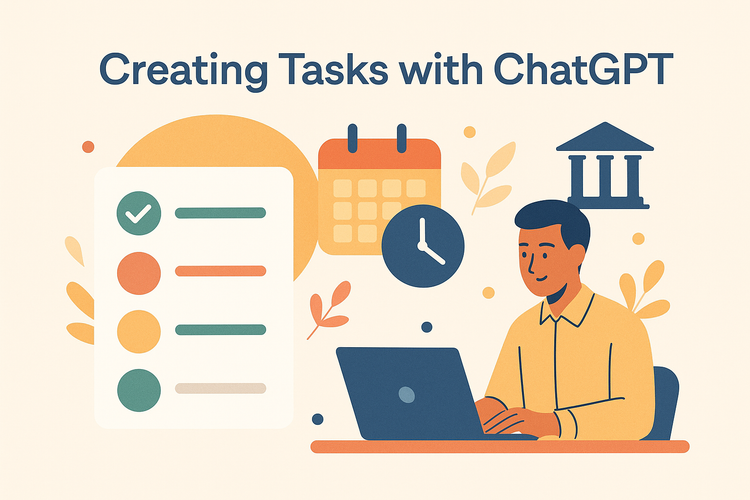Building the Future: Reimagining Lebanon's Strategic Plan with AI

How it Began
In late 2022, our City Manager, Shaun Mulholland, launched a citywide effort to develop a new strategic plan. The goal was to replace the existing Annual Outcomes and Work Plan (OWP), aligning more directly with our 20-year Master Plan—an ambitious, community-driven vision for the future of Lebanon. While the OWP helped departments structure their annual priorities, the new plan aimed to be more comprehensive, more accountable, and more deeply rooted in public input. For the first time, it would also require formal approval by City Council.
The City of Lebanon Strategic Plan was designed around ten functional areas, each with its own vision, set of objectives, key performance indicators (KPIs), and clearly identified departments, boards, and partner organizations responsible for execution. Action items were timestamped and tracked, creating a framework to both guide and measure our progress.
From the start, this was a deeply collaborative process. The City Manager met with city boards, commissions, internal teams, and the broader community through listening sessions to gather ideas. Out of these sessions, the ten strategic themes took shape—defining what mattered most to the people of Lebanon.
Capturing Our Vision
We started with Microsoft Whiteboard to gather early ideas, but quickly ran into limitations around sharing and collaboration. That led us to adopt Miro, a more flexible and visual digital workspace that let staff contribute ideas in real time.
The Miro board was dynamic and transparent. Staff could drop sticky notes, create action cards, and frame ideas by theme. It allowed us to visualize the work as it unfolded—something the public could also observe at any time. The transparency was radical and empowering. Anyone could watch the plan evolve, in real time, from the inside out.
But Miro had its downsides. As our data grew more complex, the platform struggled to keep up. It became slow to load, hard to search, and frustrating to export from. Departments couldn’t pull out the pieces they needed for council presentations or internal planning. It was great for creative brainstorming—but not for structured implementation.
Outgrowing the Space
Recognizing the limits of Miro, I led an exploration of various tools and methods to bring our strategic plan into a more usable and sustainable format. While much of the content development stemmed from a collective effort, the technical exploration—how to house, build, and scale the platform—was something I took the lead on.
Could we integrate Miro with Jira? I tested that approach. While promising, it wasn’t intuitive or widely accessible for our full team. I experimented with scraping Miro data using AI, but the results were inconsistent and cumbersome. Commercial strategic planning software platforms looked good on paper, but most were cost-prohibitive.
With each option explored, the path forward became clearer: we needed a custom solution tailored to our specific needs. That’s when I found Replit, and saw a chance to build something new—scalable, flexible, and within reach.
Traditional Takes
Even as we built the strategic plan's digital future, we also needed a way to present it in a traditional, tangible format. Community members, councilors, and department heads still needed a document they could hold in their hands—a clear, thoughtfully designed PDF presentation that told the story of our plan.
I built that document from scratch using Canva, researching how other cities across the country formatted and communicated their own strategic plans. I selected components that aligned with Lebanon’s vision, values, and communication style, and wove them into a design that reflected our local identity.
One of the most meaningful additions was our #LebanonNH Photo Gallery—a collection of photographs submitted by residents that we included throughout the strategic plan. These images, credited to the individuals who captured them, showcased daily life in our city through the eyes of the people who live here. It added a powerful sense of belonging and representation. People could literally see themselves reflected in the plan, and that mattered.
This printable, visual plan helped anchor our strategy in something familiar, but it didn’t solve the underlying issues we faced with maintaining, navigating, or expanding the content. We still needed something more interactive—more nimble. Something we could adapt to community needs as they emerged.
Prototyping
Before formally introducing the concept of using an AI agent to custom build a new portal for the City, I started building a prototype in my own personal space. On weekends and in off-hours, I experimented with Replit to see if this concept was even feasible. It was a passion project at first—a proof of concept developed quietly, guided by curiosity and the desire to solve real world problems in our city.
Eventually, I reached a point where the prototype felt viable. I had created something that not only worked but directly addressed the core frustrations with our previous system. That’s when I brought it forward for review and got the green light to officially move ahead with building a city-hosted version.
You can watch this AI-generated video I created during the build process.📺
Once I started scaling the project in Replit, it became clear that this was our path forward. The platform gave me a space where I could take all the frustrations I had been hearing from staff and the public about accessing and navigating the strategic plan—and actually do something about it. Using Replit’s AI agent, I began what I like to call "vibe coding": describing problems in natural language, testing ideas, and watching the solution unfold in real time.
Vibe coding might sound like a buzzword 🐝 —and in some ways, it is— but it has real, practical value in local government. Replit enables someone like me—without a traditional programming background but with a strong grasp of systems and workflows—to build effective, user-centered public service tools. While I may not write complex code, I understand how the pieces should fit together. Replit takes care of the technical depth, allowing me to focus on solving problems and delivering functionality where it matters most.
If we had built this internally through traditional means, we would have needed to hire a team of developers or invest in high-cost commercial software. Instead, we found a cost-effective and sustainable solution by building it ourselves using accessible AI tools. Instead, we built it for less than $200 in upfront costs.
This isn’t a solution for every city software problem. But for projects like this, it’s a sustainable, scalable approach. My job moving forward is to identify when this kind of build makes sense, and when it doesn’t. We may reach a point down the road where it makes sense to transition to something more formal or off-the-shelf. But for right now, this has been the most viable and empowering path forward.
And just as importantly: the code is backed up and synced to our GitHub repository. If we ever need to move this platform elsewhere or hand it off to a vendor, we can. That’s part of building with resilience in mind.
Migration
Once we made the decision to move forward with the Replit-based platform, one of the biggest technical hurdles was extracting all of the existing content from Miro and importing it into the new database. This wasn’t a simple export—it was a challenge that required creativity and persistence, especially because I’m not a traditional developer by training.
To solve it, I leaned into AI. I devised a workflow that involved screenshotting the action cards and theme content directly from Miro, then using ChatGPT to format the extracted information into structured JSON files. I also used Replit’s AI agents to help write an import function that could take those JSON files and populate the new database.
This process turned out to be one of the most time-saving decisions in the project. Manually transferring all of that data would have been extremely time-consuming—not to mention an unreasonable burden to place on city staff. Our departments already carry heavy workloads, and asking them to duplicate their Miro entries into the new system would have been a tough sell.
On top of that, I was very aware of the digital fatigue across our organization. Over the past few years, staff had been navigating a wave of new tools—from emergency pandemic response systems to our paperless initiative. The last thing I wanted to do was introduce yet another platform unless it truly solved a real problem.
That’s why every decision was rooted in usability and sustainability. This wasn’t about building something shiny for the sake of innovation—it was about designing a solution that worked, that lasted, and that respected the time and energy of the people who would use it every day.
Custom Features and Rapid Responsiveness
One of the most empowering parts of building our own solution was the ability to customize it to meet our needs in real time. With the data now stored in a SQL-style database, we could harness it in more dynamic ways—generating on-demand reports, building in tagging systems, and implementing role-based permissions to ensure the right people had access to the right content.
I’m especially proud of how intuitive the interface has become. (For non-technical readers: it's WYSIWYG—what you see is what you get—so staff can easily make changes directly without coding.) The tagging and search capabilities make it easy for anyone—whether a staff member or a resident—to explore the plan by filtering down to exactly what matters to them.
Hosting our own system has opened the door to agility. When a problem pops up, I can just describe it to the AI agent in Replit, ask it to build a fix, and deploy a solution—often within minutes. I recall one instance where a request came in during a morning meeting, and by mid-morning, the fix was live on the portal. That kind of responsiveness just isn’t possible with most third-party platforms.
This experience has reshaped how I think about digital tools in local government. When we own the code, we own the ability to improve it. And that’s transformative.
Innovating with Intention
By the time we reached beta, we had something better than a polished UI—we had a working system that staff could actually use.
The new platform is:
- Clean and filterable by theme, department, or tag
- Searchable and exportable for staff use
- Transparent to the public with real-time updates
- Flexible enough to evolve as our goals evolve
We used AI agents within Replit to accelerate our development process and layered in assistive AI tools to generate documentation, streamline updates, and help visualize next steps. Instead of hiring external developers or purchasing costly software, we built a tool designed by and for the people who use it.
What’s Next
Now in its beta phase, the new Strategic Plan portal is fully populated and is actively being used by staff, councilors, and the public. We're receiving feedback in real time—what’s working well, what could be improved—and using that input to shape future development. One of the aspects I'm most excited about is how this platform gives us the flexibility to respond to community needs as they arise. Because we’re not locked into a rigid third-party system, we’re free to build and adapt features that our residents ask for. The feedback we receive from our community will directly shape the future of this tool.
Some of the ideas we're exploring include:
- Refining performance and speed for a smoother experience
- Allowing users to build personalized dashboards to track the items they care most about
- Embedding feedback tools directly into the platform, so residents can share comments and suggestions without needing to leave the page
- Creating a channel for feedback to flow directly to City Council, increasing visibility into public sentiment and civic engagement
- Tracking the life cycle of action items across plan iterations and Council approvals, clarifying which items are newly proposed and which are already adopted
- Developing a way to tie action items to their fiscal impact, making budget implications more transparent to decision-makers and residents
- More tightly integrating the platform with our Master Plan, sustainability goals, and city budget—so users can better understand how strategic goals align with funding and services
This openness to iteration is one of the things I love most about the project. We’re not just building a tool—we’re co-creating a space with our community. That spirit of collaboration will guide how the platform evolves from here.
A Personal Note
This blog post is a personal reflection on my experience working on Lebanon's strategic plan platform. It was written independently and not on City time. While the initiative described here is part of my role as Chief Innovation and AI Officer, the views and storytelling expressed are my own and have not been formally reviewed or endorsed by City leadership.
I will also note that none of this work would have been possible without the vision and support of our City Manager, Shaun Mulholland. His commitment to innovation and his willingness to embrace new tools and approaches has been instrumental in giving this initiative the space to grow. From launching the original brainstorming process to supporting a beta-minded, iterative model, Shaun’s leadership has helped create an environment where creative civic solutions can take root.
And if you're reading this and wishing your city could do something similar—start with leadership. Innovation at this level doesn’t happen in a vacuum. It requires a clear vision from the top, and a willingness to make space for experimentation, learning, and growth. That’s where it begins.
When I stepped into this role, I didn’t want to just talk about AI in government—I wanted to do something with it. This project is the clearest expression of that vision so far.
If you're a fellow innovator in local government, know this: you don’t need a massive budget or a tech team to build something meaningful. You need curiosity, courage, and a willingness to start small.
Let’s reimagine what’s possible. Together.
—Melanie




Comments ()